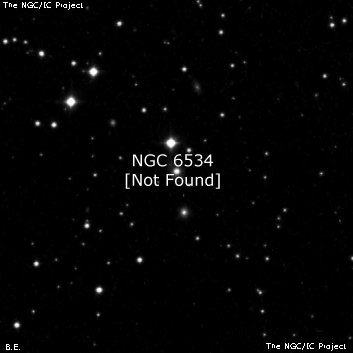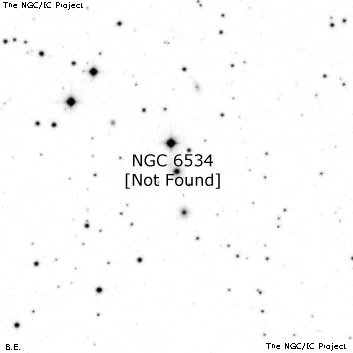NGC/IC Project Restoration Effort
(This is a very very beta version)
NGC6534


Basic Information
Location and Magnitude
Right Ascension: 17:57:18.9
Declination: +64:18:12
Constellation: DRA
Visual Magnitude:
Historic Information
Discoverer: Swift L.
Year of discovery: 1886
Discovery aperture: 16.0
Observational
Summary description: eeF, pS, R
Sub-type: NF
Corwin's Notes
=====
NGC 6534. When I looked at this nearly 20 years ago, I wrote
NGC 6534 is probably lost, like so many other of Swift's nebulae. The
galaxy that CGCG chooses (CGCG 322-022) is about 1.2 minutes of time
preceding Swift's position, and 2.3 arcmin south. Furthermore, the
surrounding star field does not match Swift's note "... in center of a
semi-circle of 4 stars." In particular, there is a fairly bright star
within an arcmin of the galaxy to the north. If Swift saw this galaxy, he
would surely have noted the star.
Are there any other candidates in the area? Galaxies that could be forced
to fit Swift's description include NGC 6505 (= UGC 11026), NGC 6536
(= UGC 11077), and CGCG 322-032. None of these, however, are at positions
that would be even digits off of the nominal position. I don't think they
are likely to be the correct nebula, either.
I'm listing the CGCG identity with a question mark. It's clear to me that
it is the wrong object, but there is nothing else that comes as close.
Searching the field again in January 2016, I see that CGCG 322-020 is in the
"... center of a semi-circle of 4 stars." It's position is 2m 45s west and
5.9 arcminutes north of Swift's place. Normally, this would not bother me too
much given what we know now about the errors that can occur in Swift's
positions -- but the other 10 galaxies he found that night all have very good
positions. The mean offset is just 3.6 seconds of time east and 36 arcseconds
north with no outstandingly bad places.
One difference to note is that the observation that became NGC 6534 is over an
hour and a half east of the mean position of the other 10 galaxies; did Swift
somehow loose his tight lock on the coordinate system that he used for the
first ten? This assumes, of course, that he swept up his nebulae in RA order.
So, there are still questions and no really good candidates. I've listed the
two most likely ones with question marks, and note again that the galaxy
chosen by CGCG has a pretty bright star less than an arcminute north that
Swift would surely have commented on.
Steve's Notes
=====
NGC 6534
24" (9/1/16): fairly faint, small, round, 15" diameter, occasional faint stellar nucleus. Located just 48" of a mag 10.4 star. A 1' pair of mag 10/11 stars is 3.5' NE. Forms a close pair with LEDA 2666218 1.2' S. The companion is faint, small, round, 15" diameter, low even surface brightness.
CGCG 322-010 lies 11' NW. At 220x it appeared fairly faint, small, slightly elongated ~N-S, 15"x10". Contains a faint stellar nucleus surrounded by a faint halo. A mag 11.8 star is 2' S, a mag 14 star is 2' ESE and a mag 13.5 star is 2' NE. CGCG 322-010 fits Swift's published description much better than CGCG 322-022, but is a poorer match in position.
17.5" (8/4/94): very faint, extremely small, round. Located 50" S of a mag 10 star. With direct vision appears stellar, about mag 15. With averted vision a very small halo is visible, perhaps 15" diameter. Located 22' NW of mag 7.7 SAO 17717. On the POSS this galaxy is almost stellar with a very faint ring.



